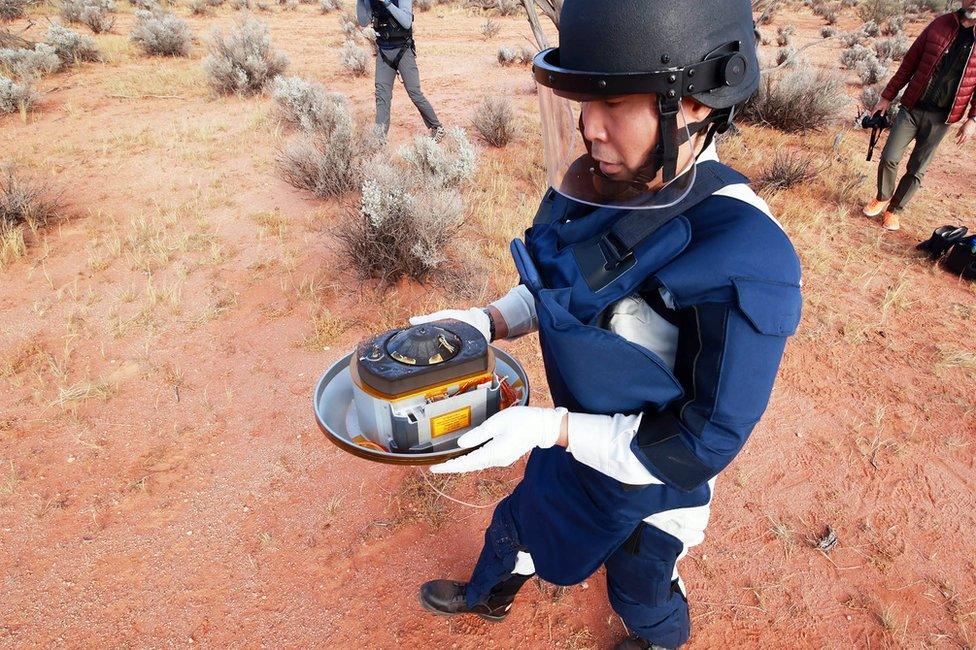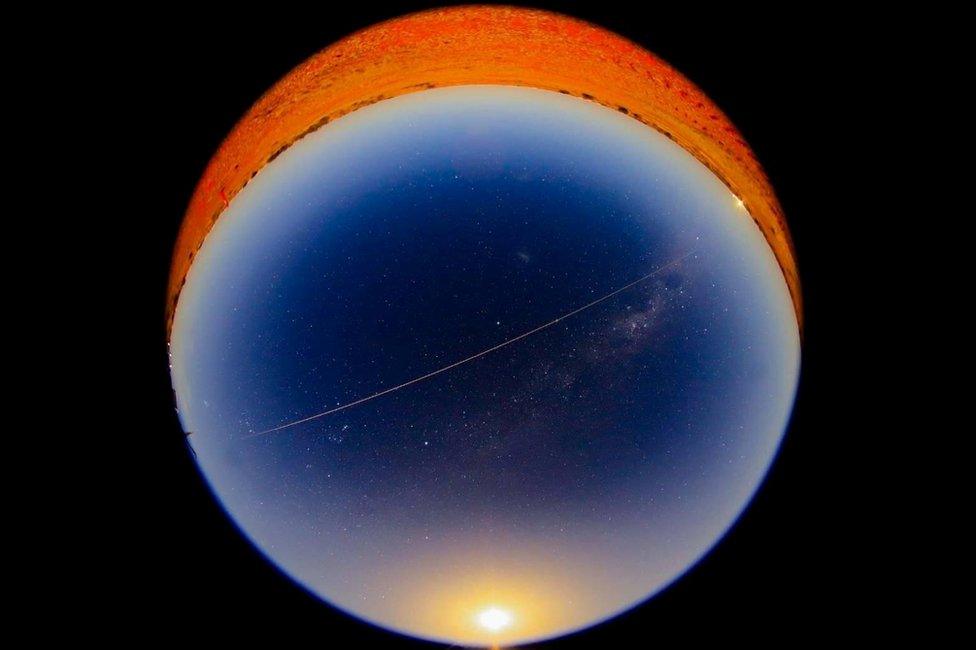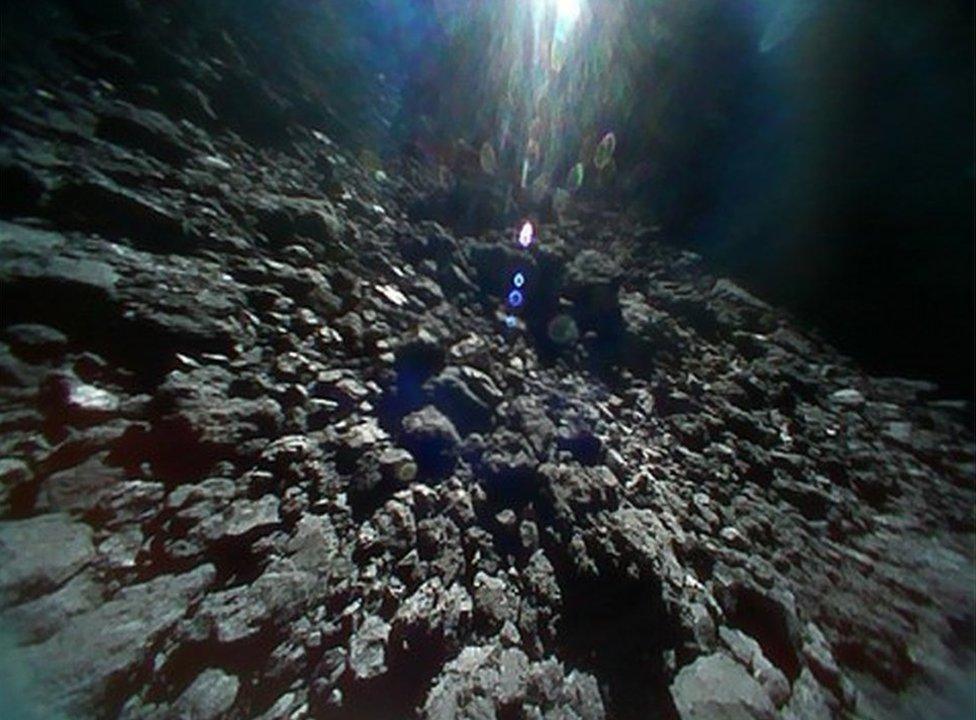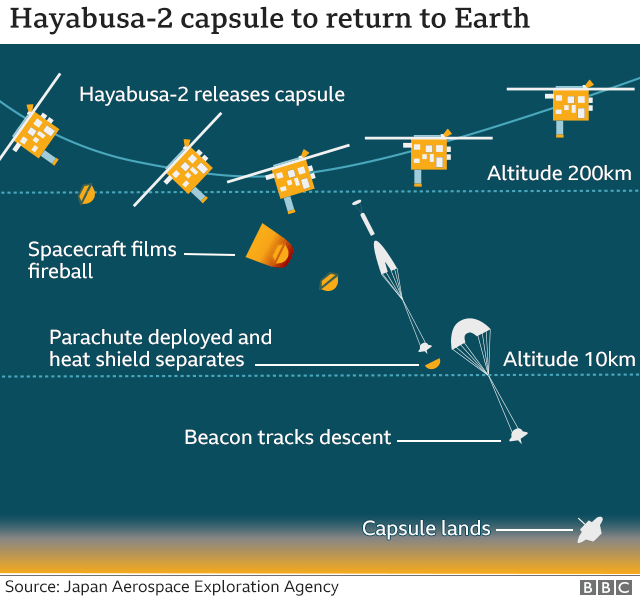Hayabusa-2: Capsule with asteroid samples in 'perfect' shape
- Published
Professor Lisa Harvey-Smith: The asteroid sample is ''exciting key'' to the origins of the Solar System
A capsule containing the first significant quantities of rock from an asteroid is in "perfect" shape, according to scientists.
The container with material from a space rock called Ryugu parachuted down near Woomera in South Australia on Saturday evening (GMT).
A recovery team in Australia found the spacecraft lying on the sandy ground, with its parachute draped over a bush.
The samples were originally collected by the Japanese spacecraft Hayabusa-2.
The spacecraft spent more than a year investigating Ryugu before returning to Earth. As it approached our planet, Hayabusa-2 released the capsule with the samples and fired its engines to push off in another direction.
The 16kg capsule, meanwhile, entered the Earth's atmosphere.
The official Hayabusa-2 Twitter account reported that the capsule and its parachute had been found, external at 19:47 GMT.
"Hayabusa-2 is home," Dr Yuichi Tsuda, project manager for the mission, said at a press conference on Sunday morning (GMT) in Sagamihara, Japan.
"We collected the treasure box," he said, adding: "The capsule collection was perfectly done."
He said there was no damage to the container.

A team member carries the capsule, which contains samples from an asteroid
Dr Hitoshi Kuninaka, director general of Japan's Institute for Space and Astronautical Science (ISAS), said: "We started development of Hayabusa-2 in 2011. I think the dream has come true."
Addressing journalists, he acknowledged past missions that had experienced technical problems, but said: "Regarding Hayabusa-2, we did everything according to the schedule - 100%. And we succeeded in sample return as planned. As a result, we can move on to the next stage in space development."
The next stage includes a mission called MMX, which will aim to bring back samples from Mars' largest moon Phobos.
Earlier on Saturday, the capsule was picked up by cameras as a dazzling fireball streaking over Australia's Coober Pedy region.
Screaming towards Earth at 11km/s, it deployed parachutes to slow its descent. The capsule then began transmitting a beacon with information about its position.

The capsule is packed into a protective box for transport to the "quick look facility"

Cameras in Australia captured the fireball as the capsule re-entered the atmosphere
The spacecraft touched down on the vast Woomera range, operated by the Royal Australian Air Force.
At around 18:07 GMT (04:37 local time), the recovery team identified the position of the capsule on the ground. A helicopter, equipped with an antenna to pick up the beacon, took to the air shortly afterwards.
Satoru Nakazawa, Hayabusa-2 sub-manager at the Japan Aerospace Exploration Agency (Jaxa), who was part of the operation at Woomera, described the search: "We went there with the helicopter and it was emitting the beacon signal. But at that time, it was still dark, so it was unclear [where it was]. I was very, very nervous.
"We flew over the area [where it landed] many times and I thought maybe that was where it was. Then the Sun rose and we could visually confirm the existence of the capsule. We thought: 'Wow, we found it!"
"But we had a very jittery, frustrating time until sunrise."
The capsule was then taken to a "quick-look facility" for inspection. On Monday, Jaxa said it had collected gases from inside the container for analysis, adding that it was still not known whether they come from the Ryugu sample.
Allow X content?
This article contains content provided by X. We ask for your permission before anything is loaded, as they may be using cookies and other technologies. You may want to read X’s cookie policy, external and privacy policy, external before accepting. To view this content choose ‘accept and continue’.

Afterwards, the capsule will be airlifted to Japan, where it will be transported to a curation chamber at Jaxa in Sagamihara for analysis and storage.
The mission planned to collect a sample of more than 100mg from the asteroid Ryugu.
Prof Alan Fitzsimmons, from Queen's University Belfast, said the sample would "reveal a huge amount, not only about the history of the Solar System, but about these particular objects as well".
Asteroids are essentially leftover building materials from the formation of the Solar System. They're made of the same stuff that went into forming the Earth, but they avoided being incorporated into planets.
"Having samples from an asteroid like Ryugu will be really exciting for our field. We think Ryugu is made up of super-ancient rocks that will tell us how the Solar System formed," Prof Sara Russell, leader of the planetary materials group at London's Natural History Museum, told BBC News.
Studying the samples from Ryugu could tell us how water and the ingredients for life were delivered to the early Earth.

A rover deployed by Hayabusa-2 sent back this image from the surface of Ryugu
It had long been thought that comets delivered much of the Earth's water in the early days of the Solar System. Alan Fitzsimmons said the chemical profile of water in comets was sometimes rather different from the profile of water in our planet's oceans.
The water composition of some asteroids in the outer Solar System, however, is a much closer match. Ryugu probably originated in this cold zone, before migrating inwards to its current orbit, closer to Earth.
"It may be that we've been looking to comets all this time for delivering water to Earth in the early Solar System. Perhaps we should have been looking a bit closer to home, at these primitive but rather rocky asteroids," Prof Fitzsimmons told BBC News.
"Indeed that's something that will be looked at very carefully in these Ryugu samples."
Researchers from around Japan, and other countries, will be working with the samples. In the UK, Prof Russell's team at the Natural History Museum and scientists from the universities of Manchester and Glasgow will get to study the material.
Dr Sarah Crowther is one of several researchers at Manchester expecting to receive samples next year. She explained: "Different labs contribute different expertise, which all helps in understanding the material collected."
The Hayabusa-2 spacecraft, which bypassed the Earth after releasing its capsule, is being sent on another mission. It will now travel to a much smaller, 30m-wide asteroid, reaching it in 2031.
Follow Paul on Twitter., external
